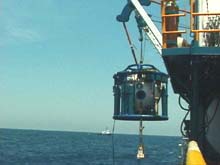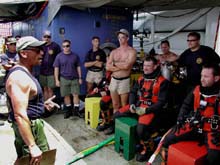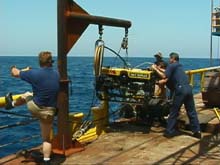
This saturation bell is a chamber that divers use to acclimate their bodies to the extreme pressures below the surface. This marked the first time that Navy divers used a civilian saturation system during official operations. Photo courtesy of U.S. Navy. Click image for larger view.

Divers on one of the two Navy diving teams listen carefully as they are briefed. Each team worked 12 hrs/day, seven days/wk in an effort to recover the Monitor's engine. Photo courtesy of U.S. Navy. Click image for larger view.
The Navy MR-2 remotely operated vehicle, which is being launched, gave the topside crew a "fish-eye view" of the Monitor wreckage. In addition, it provided video and still image doncumentation. Photo courtesy of U.S. Navy. Click image for larger view.
Monitor 2001 - Phase II
Securing the Barge
June 19, 2001
Dr. John Broadwater, Manager
Monitor National Marine Sanctuary
Captain Christopher Murray
NAVSEA, U.S. Navy
Mr. Jeffrey Johnston, Historian
Monitor National Marine Sanctuary
Commander Barbara Scholley
Mobile Diving and Salvage Unit Two, U.S. Navy
Quite a lot has happened since our last update. After departing Louisiana on June 3, the Derrick Barge Wotan had a very rough and slow passage across the Gulf of Mexico, thanks to Tropical Storm Allison. After rounding the tip of Florida and picking up speed in the Gulf Stream, the barge once again encountered Allison, forcing an unscheduled stopover in Morehead City, NC. By June 16, Allison had finally passed us by. At noon, we departed Morehead City with over 100 crew and divers aboard. We arrived at the Monitor National Marine Sanctuary at first light on Sunday, June 17 -- Father’s Day. We were greeted by a beautiful, calm day, which turned out much better than the previous evening’s weather forecast! Before 11 am, the DB Wotan was in position directly over the wreck of the Monitor, held firmly in place by eight anchors weighing in at 20,000 lbs each.
We immediately began working a schedule of two 12-hr shifts per day, seven days per week. Captain Chris Murray, the Navy's On-scene Commander, and Dr. John Broadwater, NOAA’s Expedition Chief Scientist, were on duty from 6 am to 6 pm, while Commander Bobbie Scholley, Commanding Officer of the Navy's Mobile Diving and Salvage Unit Two, and NOAA Historian Jeff Johnston covered the night shift. Likewise, the barge crew, surface-supplied dive teams, saturation (SAT) dive teams, and support crews were on two daily watches. The eight-person galley crew also worked hard, serving four full meals a day to keep both watches well fortified.
On Sunday, the SAT system and the surface-supplied dive system were both checked out and a number of minor repairs and adjustments were made. The night shift made three dives, installing the hydraulic “lifting engines” that will raise the Monitor 's steam engine to the engine recovery structure (ERS). The Monday day shift completed four dives, continuing the ERS work. The evaluation of the SAT system continued through the day and into the evening, when four divers were pressurized to 180 ft for final testing. The evaluation dive was completed at 2 am on Tuesday, June 18. This was an historic event, during which Navy divers teamed with Global Industries, a civilian company. This marked the first time that Navy divers used a civilian saturation system during official operations.
The Global Industries saturation system will be used for the remainder of the Monitor mission, allowing each Navy SAT diver to conduct working dives of up to four hrs in duration. At the same time, another team of Navy divers will be conducting round-the-clock dive operations using a surface-supplied dive system. These divers descend on a “stage” or platform, remaining underwater for up to 40 min per dive. This teamwork will make it possible for up to three divers to work together on complex tasks. For additional support, a Navy MR-2 ROV (remotely operated vehicle) will maneuver around the site to give topside personnel a “fish-eye view" of the underwater work, and to provide video and still image documentation.
With the expedition officially under way, and with the unpredictable Hatteras weather cooperating nicely, our efforts to recover the Monitor’s engine are proceeding as planned.
Sign up for the Ocean Explorer E-mail Update List.























